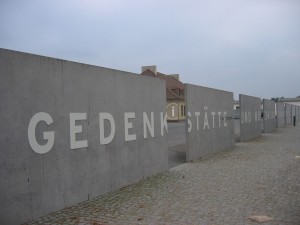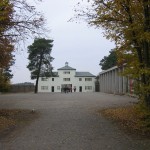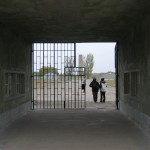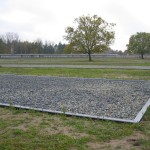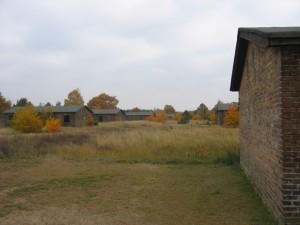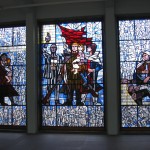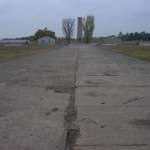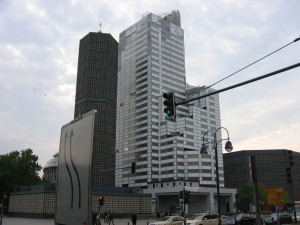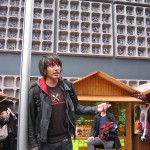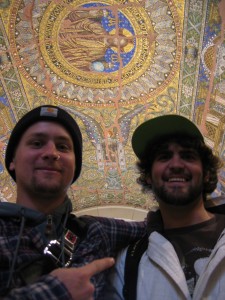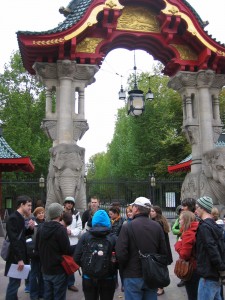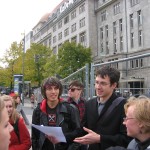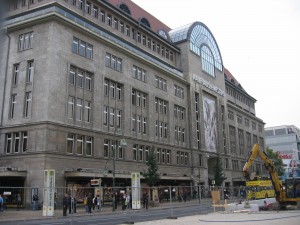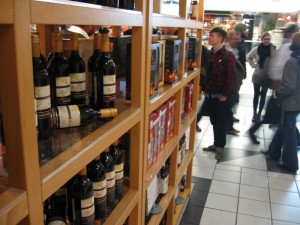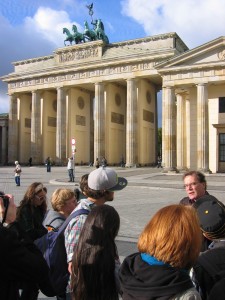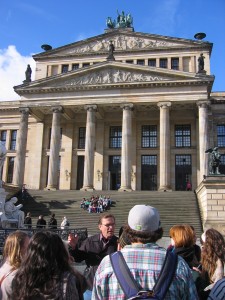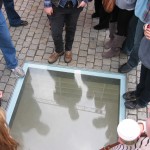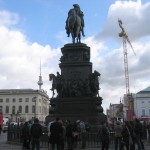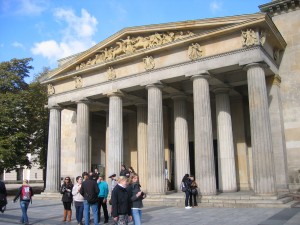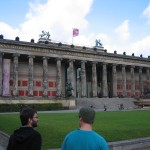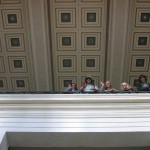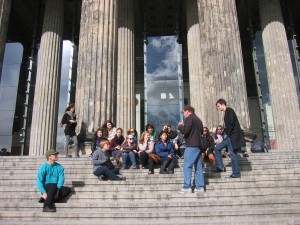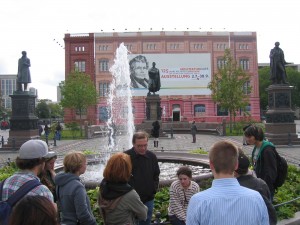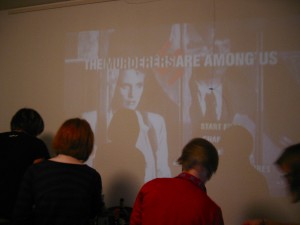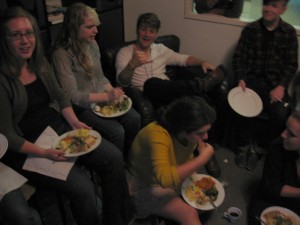KZ Sachsenhausen: four layers of memory
Our visit to Buchenwald last weekend left us all with much to think about concerning the troublesome history of the Holocaust and the aftermath of WWII. This past Friday, we visited another concentration camp site, this time much nearer to Berlin. As opposed to Buchenwald, which is somewhat removed from the town of Weimar, Sachsenhausen is set essentially within the town of Oranienburg. The students were shocked to see how close the camp was to the surrounding houses: it reveals much about the attitude of many Germans toward the existence of these sites during the Nazi era.
The exhibitions and interpretive materials on the site (which is still in the process of being remodeled) seek to reveal four major eras in the camp’s existence. The first is the building and use of the camp by the Nazis, beginning in 1936. Though many Jews were imprisoned here, it was better known as a camp for political prisoners, especially Communists. It was also a prominent training site for the SS, as well as a “show” camp for Hitler and his officials. Though it wasn’t a death camp, tens of thousands of prisoners died here as a result of starvation, disease, abuse, and torture, as well as medical experiments.
After the war, the Soviets used Sachsenhausen as a “special camp” where they held various German prisoners to await trial. (Above: extra housing outside the camp walls which was used during this time.) Several thousand people died during this stage of the camp’s existence – mostly of starvation, disease and exposure. It’s difficult to know what to do with the memory of these deaths, as many of the prisoners were either Nazis themselves, or had been willing participants in the culture of the regime. Still, the evidence of human suffering here is also staggering.
After the Soviets abandoned the camp, the GDR government refurbished it (as they did Buchenwald) as a memorial site. Here at Sachsenhausen, this included a large memorial structure (where soldiers were regularly inducted into the army), as well as a museum that emphasized the suffering of the Communist prisoners held here by the Nazis. For East Germany, the identity of the Communists as victims of the fascist regime was a central part of the national narrative, so sites like these became points for the public expression of collective persecution at the hands of the Nazis – even if very few GDR citizens had actually been Communists prior to 1945. On the other hand, the memory of the Soviet camp was completely suppressed under the East Germans, so that families who had lost loved ones here during the post-war period were unable to speak about their own suffering until after 1989.
With the fall of the wall, the camp became a flashpoint for conflicting narratives and memories: how can both victims of the Nazis and Nazis or collaborators themselves be remembered and mourned on the same site? This is a question that haunts many spaces in Berlin, not only Sachsenhausen. The current design of the site attempts to deal with this through a “decentralized” approach, using the various structures to house extensive exhibitions of archival material. Still, we’re left wondering: how do we decide who has the right to be remembered, and how?
There are many more buildings on the site, but I couldn’t bring myself to photograph them. Sites of terrible suffering and unspeakable crimes, I think they are best left to be pondered in the abstract. If you’re interested, however, you can read more about the site here.
Ku’damm, Zoo and KaDeWe with Robert, Dan and Niguel
Our students Robert, Dan and Niguel took us on a great tour of the Ku’Damm/Zoostation area of Berlin this Tuesday. We began just off the Ku’Damm at the Gedächtniskirche – the ruin of a church built by Kaiser Wilhelm II and bombed in 1943. The ruin has become one of the symbols of Berlin, but you can’t see it at the moment – it’s under that ugly white scaffolding you can see in the picture above. Surrounding the ruin are a chapel and belltower designed by the German modernist Egon Eiermann in the 1950s.
We headed into the ground floor of the ruin first. The ceiling still displays some beautiful Byzantine-style mosaics, duly appreciated by our class …
We then headed next door to the Eiermann-designed chapel. Though the newer buildings aren’t much to look at from the exterior (Berliners have nicknamed them the “lipstick and powder box”), the chapel is pretty stunning on the interior. We caught the organist practicing, which added to the atmosphere.
Our next stop was the zoo, where our guides not only acquainted us with the incredible diversity of its inhabitants – the most in the world! – but related the heartbreaking story of Knut, the baby polar bear born in the zoo in 2006. Knut was a media favorite (with good reason – he really was incredibly adorable!), but unfortunately he died earlier this year.
The mood picked back up as we moved to our last stop, the famous Kaufhaus des Westens, or KaDeWe. It’s the biggest department store in continental Europe, with a history that spans over 100 years.
The top floor of the store is known for its incredible selection of foods, both local and imported. And what should we find as we come up the escalators but a little taste of home – Columbia Crest, on sale. It seems we’re not the only Washington imports to Berlin!
A walk through Schinkel’s Berlin with John Toews
On Wednesday John took us on a tour of Berlin’s historical district, known as Mitte. The focus of our walk was the city as it was in the 19th century, when its inhabitants included some of the leading intellectuals of the time, and the city styled itself as “Athens on the Spree.” We began at the Brandenburg Gate, designed by Carl Gotthard Langhans in the late 18th century as a kind of propylaea leading into Berlin. Karl Friedrich Schinkel had a hand in redesigning the staff held by the goddess of peace who crowns the monument.
We continued on to Schinkel’s Schauspielhaus (now called the Konzerthaus) on the Gendarmenmarkt, a somewhat early commission and an example of the architect’s turn toward neoclassicism.
On the Forum Fridericianum, a square built under Frederick the Great (whose monument you see on the right), there is now a memorial to the book burnings that took place there in the 1930s. The square is home to the former Royal Library, now housing Humboldt University’s law school. Interestingly, we learned that the book burnings were not carried out by Nazi officials, but rather by zealous student party members.
Next stop: the Neue Wache, a guardhouse designed by Schinkel along Unter den Linden. The building has been the site of numerous memorials over the course of the 20th century, including both East German and reunified German commemorations of World War II.
One of Schinkel’s masterpieces, not only of architecture but of urban planning, is the Altes Museum. Sitting across from the site of the royal Prussian palace (not currently extant), the building housed the first true modern museum in Europe. Schinkel designed it to integrate the viewer’s experience of art with that of the urban environment: he provided a viewing platform on the interior of the building, from which visitors could contemplate the royal gardens, palace, and the cityscape beyond.
The tour wrapped up near the site of Schinkel’s Bauakademie – his architectural and design academy. The building is also considered one of his masterworks, and was unfortunately torn down in the post-WWII period. This nylon-covered scaffolding has been here for years, but there’s no money to rebuild it. Its ghostly presence reminds us of the many memories and layers that reside amongst one another in Berlin’s cityscape.
Movie Night: The Murderers Are Among Us
We had our first movie night this week, and as our theme for seminar was Trümmer – rubble – it seemed appropriate to screen The Murderers Are Among Us. Shot in 1945-46 on location in war-torn Berlin, it’s the story of love, loss and revenge, and a meditation on the ravages of WWII. Distributed by the Russians, the ending of the film (the main character was originally supposed to kill his former commanding officer) had to be changed because it was thought that it might instigate revenge killings.
Our evening began with an amazing potluck, courtesy of the students, including curry, crepes and other delicacies prepared in the kitchens of their Arwobau apartments. We then continued with a cozy screening in the living room of Rachel, Annie and Melissa’s apartment. (We have a teeny tiny projector and speakers provided by CHID — they work wonderfully!)
All agreed that the movie was pertinent, moving and beautiful, even if we did think that the couple fell in love a little too fast for our modern sensibilities … a highly recommended film about post-war Germany.
tags
the author
I'm a doctoral student at CUNY Graduate Center. I'm thrilled to be teaching the CHID Berlin program with Prof. John Toews! You can contact me at naraelle [at] gmail.com, or find out more about me at www.naraelle.net.
Blogroll
- Annie Holden's blog
- Cassie Hoeprich's blog
- Dominic Barrera's blog
- Janet Williams's blog
- Mariah Alderete's blog
- Melissa Au's blog
- Robert Hampton's blog
- UW Students Study Abroad Our students Natalie and Cassie are contributing to the official IPE student blog this fall!



